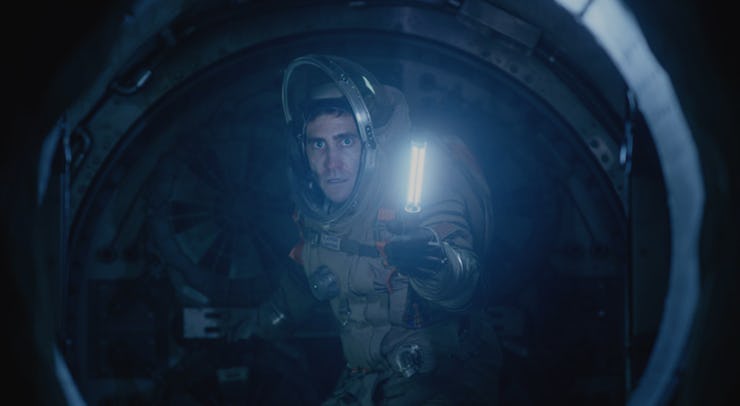Daniel Espinosa’s surprisingly not terrible space flick, Life, works on a formula notably perfected by Alien: Dump a bunch of people into a cloistered, confined spacecraft with little room to move, too many dimly lit areas, not enough exit points, and a monster that makes any nightmare pale in comparison. Spoilers ahead.
That alien, however, defies the laws of physics and can’t exist. Here’s why.
Let’s start with the alien’s origin story. The crew of the International Space Station is tasked with examining some Martian soil samples for signs of biological activity — ostensibly, to see if there’s evidence of life. Resident astrobiologist, Hugh Derry (played by Ariyon Bakare), runs assays and finds a large, single-celled organism — inert, but with a fully intact nucleus, cytoplasm, cell wall, cilia, and flagella.
Within the station’s lab, Derry begins to manipulate conditions under the sealed hood to see if the lifeform can be brought back to, well, life — a fully moving creature that operates on its own. And with the help of a toasty 20 degree Celsius temperature, an Earth-like, oxygen-rich atmosphere, and a dab of glucose to provide an impetus for growth, Derry succeeds in what Roy Adams (Ryan Reynolds) calls “Re-Animator shit.”
The alien in 'Life', named Calvin
The alien organism, horribly dubbed “Calvin,” grows phenomenally fast into a multi-cellular organism, exhibiting an electrical network throughout its entire being. Every cell, Derry alleges, is characteristic of both receptor cells, neuronal cells, and muscle cells. “All muscle, all brain, and all eye,” he says of Calvin. Even more bizarre, Calvin is able to essentially make its own appendages. Within seconds, it morphs its tissue to interact with its environment, reacting to its surroundings, and possessing all the sensory capabilities of humans.
Calvin, in other words, has the makings of a monster. But its size and biomechanics are impossible, due primarily to the lab in which it’s nurtured. First and foremost, Calvin has a finite set of resources to grow. It’s small. If Derry is the responsible biologist he claims to be, then he’s probably being pretty stringent with the nutrition he offers the alien. The extraordinarily rapid growth of Calvin suggests the organism is able to create exponentially more mass and growth with its food intake than it really should be able to. This might have made sense if Calvin was photosynthetic and was processing sunlight along with external sugars for energy. But at no point does the movie make such a claim.
When Calvin finally gets loose, we see it consume a mouse and grow about four or five times bigger than its original dimensions. Again, this seems impossible. The same exponential growth occurs when the alien kills and eats Adams (only his innards). Sure, Calvin is portrayed as an advanced organism than anything found on Earth, but its astounding ability to transform food into exponential growth lacks any explanation.
It’s also made clear that Calvin is an incredibly smart being. At one point early in the film, Derry prods at the specimen with a voltage-lined wand, waking (and simultaneously irking) Calvin into hostility. After crushing Derry’s hand, Calvin seeks a way out of the sealed laboratory hood. He finds it by breaking the rubber gloves using the broken wand.
Prior to this, Calvin had never interacted with tools and learned how to handle them. Inherent intelligence does not immediately translate to known experience. There’s no reason to think Calvin had already possessed the kind of problem-solving ability that would allow him to immediately think to use the wand’s sharper edges to pierce through the gloves and get free.
So these problems push the limits of biological feasibility, but they also aren’t completely unthinkable for an organism, especially an extraterrestrial one. But Life jumps the believability ship halfway into the movie, when Calvin, now the size of a small adult, breaks out of the space station’s confines and finds its way to the outside of the spacecraft — an environment where it’s exposed to literally everything that should annihilate it.
Earlier in the film, the audience is informed that Calvin essentially requires all of the things that complex life on Earth requires as well to survive: water, oxygen, nutrients, energy. We can therefore assume Calvin’s biology operates in fundamentally the same way — his cells and tissues are mostly water, and he exhibits an internally modified pressure system that allows the exchange of gases and liquids throughout the body.
With that in mind, we need to remember what happens to a living thing when it’s exposed to the vacuum of space. No oxygen to the brain means a quick loss of consciousness and cognitive activity. Calvin’s neural composition indicates a total body shutdown. Furthermore, humans use hemoglobin to transfer oxygen, and Calvin may very well use something else — but no matter what it uses as an oxygen transport, the low pressure of space prohibits proper circulation. That goes beyond space as well to Calvin’s initial life without a spacesuit. Without one, Calvin’s oxygen should plummet in space. No use arguing that Calvin held its breath; that would only cause its tissues to rupture, since the oxygen is getting out one way or another. Whatever water is sitting in Calvin’s body would evaporate, causing its muscle tissue to swell. And its body’s internal pressure falls, the liquid in its cells would start to boil. Within about two minutes, we could expect Calvin to experience a horrendously painful death.
Yes, it’s a science fiction/horror movie, but rest easy — Calvin simply can’t exist.
